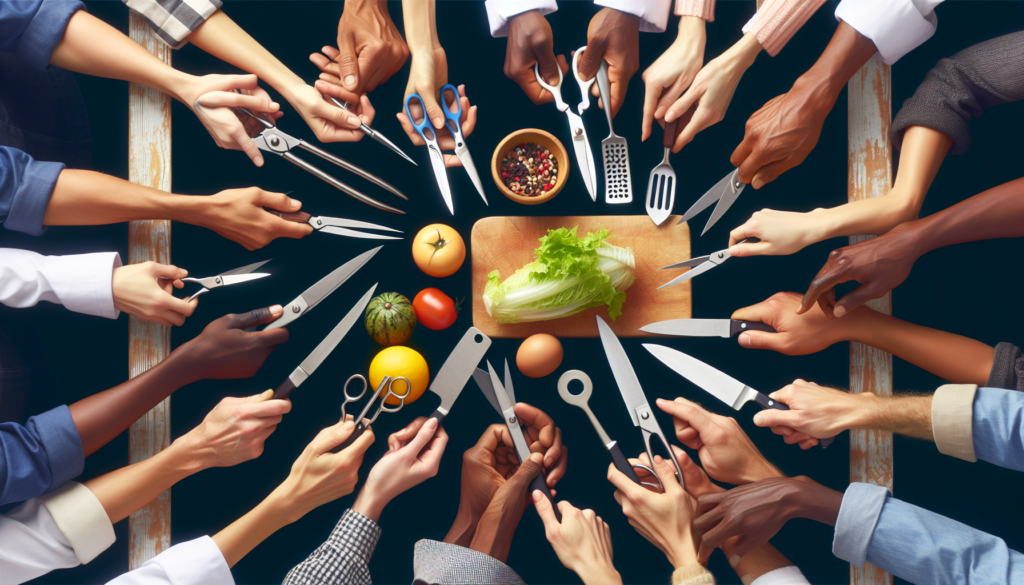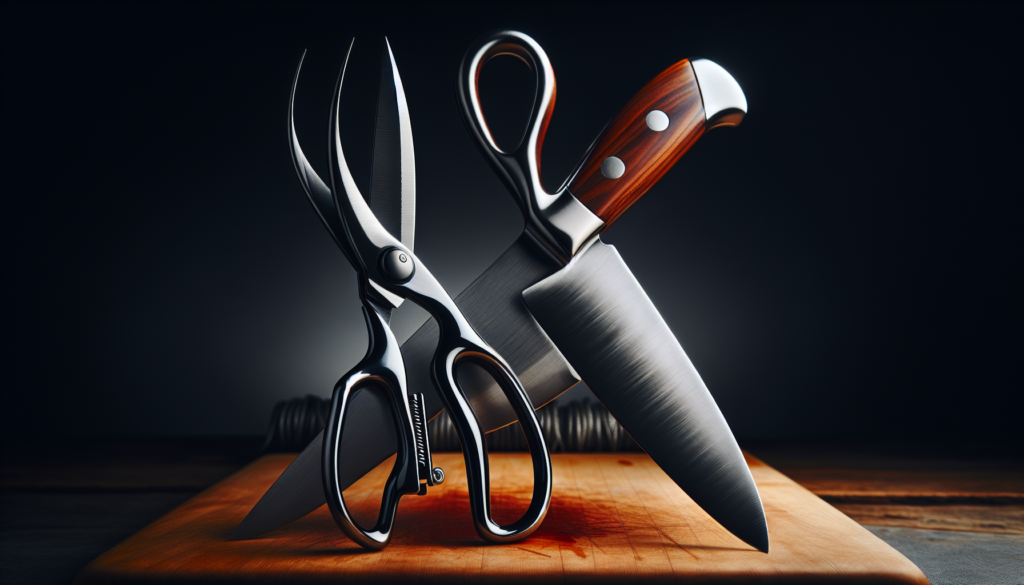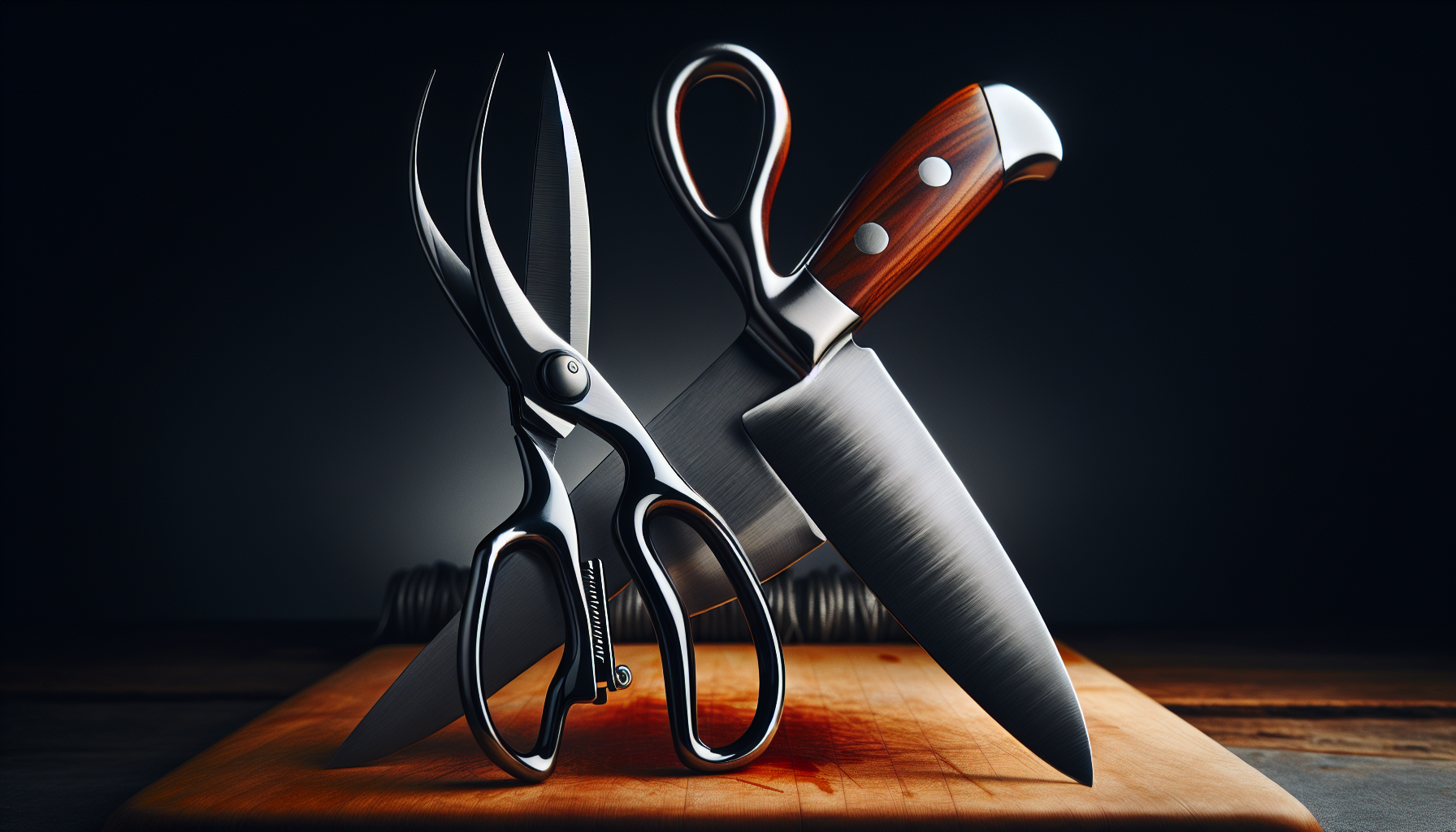Kitchen Shears Vs. Chef’s Knife: What’s Best For You?
Are you a food enthusiast or someone who just wants to whip up delicious meals at home? If so, then you’ve probably come across the dilemma of choosing between kitchen shears and a chef’s knife. Both are essential tools in any kitchen, but which one is the best fit for you? In this article, we’ll explore the pros and cons of both kitchen shears and a chef’s knife, helping you make an informed decision and elevate your culinary skills to the next level.

Differentiating Kitchen Shears and Chef’s Knife
Kitchen shears and chef’s knives are both important tools in the kitchen, but they serve different purposes and have their own unique features. Knowing the differences between the two can help you choose the right tool for specific tasks.
Definitions
Kitchen shears, also known as kitchen scissors, are a versatile tool primarily used for cutting various ingredients, such as herbs, vegetables, poultry, and more. They typically have a strong, sharp blade and handles that make it easy to grip and control.
On the other hand, a chef’s knife, also known as a cook’s knife, is a multi-purpose knife with a wide blade that tapers to a sharp point. It is commonly used for slicing, dicing, and chopping ingredients. Chef’s knives come in different sizes, with the most common being around 8 inches in length.
Functionalities
The functionality of kitchen shears and chef’s knives differ based on their design and construction.
Kitchen shears excel at tasks that require precision cutting, such as snipping herbs or trimming fat from meat. They also come with additional features like built-in bottle openers, screwdrivers, or nutcrackers, which can be handy in the kitchen. Some models even have detachable blades for easy cleaning.
Chef’s knives, on the other hand, are designed for versatility. They are ideal for tasks like slicing vegetables, mincing garlic, and chopping meat. With their long, sharp blades, they can handle a wide range of cutting tasks with ease. The curved belly of the blade allows for a rocking motion, making it efficient for chopping and dicing.
Pros and Cons
Kitchen shears and chef’s knives each have their own set of advantages and disadvantages.
Kitchen shears are incredibly versatile and can handle a wide range of cutting tasks. They are particularly useful for tasks that require precision, such as snipping herbs or trimming fat from meat. However, their shape and limited blade length may not be suitable for larger cutting tasks or tasks that require a rocking motion.
Chef’s knives, on the other hand, are incredibly versatile and can handle almost any cutting task in the kitchen. Their long, sharp blades and ergonomic design make them comfortable to use for extended periods. However, they may lack the finesse and precision that kitchen shears offer, especially for tasks that require delicate cutting.
Comparing Cutting Power
When it comes to cutting power, both kitchen shears and chef’s knives have their strengths. Let’s take a closer look at each.
Kitchen Shears
Kitchen shears are designed with a strong, serrated blade that can handle tough and fibrous ingredients. The serrations help the shears to grip the food securely and prevent it from slipping while cutting. This makes them ideal for tasks like cutting through poultry bones, lobster shells, or even opening packaging.
The leverage provided by the handles of kitchen shears also gives them additional cutting power, which can make tasks easier and quicker. However, it’s important to note that kitchen shears may not be as efficient as chef’s knives when it comes to slicing and dicing softer ingredients.
Chef’s Knife
Chef’s knives are known for their cutting power, making them a go-to tool in the kitchen. The wide, sharp blade allows for effortless cutting through various ingredients, including fruits, vegetables, and meat. The weight and balance of the knife also contribute to its power, allowing you to slice through thick cuts with ease.
The long, thin blade of a chef’s knife enables it to make precise cuts, especially for tasks like julienning or chiffonading. The rocking motion that can be achieved with a chef’s knife allows for efficient and consistent chopping and slicing. However, in terms of sheer cutting power, kitchen shears may have the upper hand when it comes to tougher ingredients.
Versatility in Cutting Tasks
In terms of versatility, both kitchen shears and chef’s knives have their own strengths and weaknesses.
Kitchen Shears
Kitchen shears are incredibly versatile and can handle a wide range of cutting tasks. Their ability to tackle tough ingredients like poultry bones, lobster shells, and thick packaging sets them apart. They are also useful for tasks like trimming fat, cutting herbs, or even opening food packaging.
Additionally, some kitchen shears have other useful features, such as flathead screwdriver tips or bottle openers, which can come in handy in the kitchen. However, when it comes to slicing through softer ingredients or delicate cutting tasks, kitchen shears may not be as precise as chef’s knives.
Chef’s Knife
Chef’s knives are renowned for their versatility in the kitchen. Their long, sharp blades and ergonomic designs make them suitable for a wide array of cutting tasks. From slicing vegetables and fruits to mincing garlic and chopping meat, chef’s knives can handle it all.
The curved belly of the chef’s knife allows for a rocking motion, which makes it efficient for chopping and dicing ingredients. The sharp tip of the blade is also useful for intricate tasks like scoring meat or slicing herbs. However, for tasks that require more leverage, like cutting through tough packaging or snipping poultry bones, kitchen shears may be a better choice.
Precision and Control
When it comes to precision and control, both kitchen shears and chef’s knives have their own advantages.
Kitchen Shears
Kitchen shears offer excellent precision and control for tasks that require delicate cutting. The serrated blades and the ability to grip the food securely allow for precise snipping of herbs or removing the skin from fish fillets. The short blades also make it easier to control the cutting direction and make small, intricate cuts.
The comfortable grip provided by the handles of kitchen shears further enhances control, allowing you to make accurate cuts. However, the short blades of kitchen shears may not be suitable for larger cutting tasks or tasks that require a rocking motion.
Chef’s Knife
Chef’s knives are known for their precision and control, especially when it comes to slicing and dicing ingredients. The long, thin blades allow for precise cuts, making tasks like julienning or chiffonading a breeze. The ability to rock the blade also provides excellent control for chopping and mincing.
The ergonomic design and comfortable grip of a chef’s knife contribute to its overall control. The weight and balance of the knife provide stability and allow for smooth, controlled cutting. However, for tasks that require more finesse or delicate cutting, kitchen shears may offer better precision.

Ease of Use and Convenience
Both kitchen shears and chef’s knives have their own advantages when it comes to ease of use and convenience.
Kitchen Shears
Kitchen shears are incredibly easy to use and can be operated with one hand, making them convenient for quick cutting tasks. The built-in features like bottle openers or screwdriver tips add to their convenience. Many kitchen shears also come with detachable blades, making cleaning a breeze.
The handles of kitchen shears are designed for a comfortable grip, reducing strain and fatigue during use. The spring-loaded mechanism of some kitchen shears further adds to their ease of use, allowing for effortless, repetitive cutting motions. However, the shape and size of kitchen shears may not be as suitable for larger cutting tasks or those that require a rocking motion.
Chef’s Knife
Chef’s knives are incredibly easy to handle and manipulate, thanks to their ergonomic design and balanced weight. The long, sharp blades allow for smooth, controlled cutting motions. The versatility of a chef’s knife also means that you can use it for a wide range of cutting tasks, reducing the need for multiple tools.
The simple design of a chef’s knife makes it easy to clean, and many models are also dishwasher-safe. However, due to their size and shape, chef’s knives may require two hands to operate efficiently. Using a chef’s knife also requires some degree of skill and technique to achieve the best results.
Ergonomics and Grips
The ergonomics and grips of kitchen shears and chef’s knives play a crucial role in user comfort and efficiency.
Kitchen Shears
Kitchen shears are designed with user comfort in mind. The handles of kitchen shears are typically made of materials like plastic or rubber, providing a comfortable grip. The shape of the handles allows for a secure hold, reducing the risk of slipping or accidents while cutting.
Some kitchen shears also feature ergonomic designs, with curved handles that fit comfortably in the hand. The spring-loaded mechanism can further reduce strain and fatigue during extended cutting sessions. However, the shape and size of kitchen shears may not be suitable for all hand sizes, and some users may find them less comfortable for larger cutting tasks.
Chef’s Knife
Chef’s knives are designed to be ergonomic, providing a comfortable grip that allows for extended use without causing strain or fatigue. The handles of chef’s knives are often made of materials like wood, plastic, or composite, offering a secure grip.
The shape and size of the handle are typically designed to fit comfortably in the hand, allowing for precise control and maneuverability. Some chef’s knives also feature textured handles that enhance grip and prevent slipping. However, it’s important to choose a chef’s knife with a handle that fits your hand size and feels comfortable to hold.
Maintenance and Durability
The maintenance and durability of kitchen shears and chef’s knives are important factors to consider when choosing between the two.
Kitchen Shears
Kitchen shears are relatively easy to maintain. Many models are dishwasher-safe, making cleaning a breeze. However, it’s important to check the manufacturer’s instructions to ensure that your kitchen shears can be safely cleaned in the dishwasher.
For handwashing, kitchen shears can be cleaned with warm, soapy water and a brush to remove any food residue. It’s essential to dry the shears thoroughly after washing to prevent rust or damage to the blades.
In terms of durability, kitchen shears are typically constructed with stainless steel blades that are resistant to corrosion and wear. However, the durability may vary depending on the quality of the shears. It’s important to choose a reputable brand that offers a warranty or guarantee.
Chef’s Knife
Chef’s knives require proper maintenance to ensure their longevity and performance. Handwashing is recommended for chef’s knives, as the high heat and harsh detergents in a dishwasher can damage the blade and handle.
To clean a chef’s knife, wash it with warm, soapy water and a soft sponge or cloth. It’s important to dry the knife immediately after washing to prevent rust or damage to the blade. Regular sharpening and honing are also essential to maintain the knife’s sharpness and cutting performance.
Chef’s knives are typically made from high-quality stainless steel or carbon steel, known for their durability. However, the longevity of the knife will depend on the quality of the materials and craftsmanship. Investing in a reputable brand and proper maintenance can ensure the durability of your chef’s knife.
Cost and Value for Money
The cost and value for money play a significant role in determining whether kitchen shears or chef’s knives are a better choice for your needs.
Kitchen Shears
Kitchen shears are generally more affordable compared to chef’s knives, making them a cost-effective option. The price range for kitchen shears can vary depending on the brand, quality, and additional features. However, even high-quality kitchen shears are typically less expensive than a good-quality chef’s knife.
Considering the versatility and functionality of kitchen shears, they offer great value for money. With their ability to handle a wide range of cutting tasks, the convenience of additional features, and the durable construction of stainless steel blades, kitchen shears are a worthwhile investment for any kitchen.
Chef’s Knife
Chef’s knives are often considered a valuable investment for anyone serious about cooking. While they may be more expensive compared to kitchen shears, they offer exceptional quality, durability, and performance. A good-quality chef’s knife can last for many years with proper care, making it a worthwhile investment in the long run.
Chef’s knives come in a range of price points, depending on factors such as the brand, materials used, and craftsmanship. It’s important to consider your budget and choose a chef’s knife within your price range that offers the best balance of quality and performance.
Recommended Cutting Tasks
To help you decide which tool is best for your cutting tasks, let’s look at some recommended uses for kitchen shears and chef’s knives.
Kitchen Shears
Kitchen shears are recommended for tasks that require precision cuts or handling tough ingredients. They are particularly useful for:
- Trimming fat from meat
- Snipping fresh herbs
- Cutting through poultry bones
- Opening food packaging
- Shelling seafood
- Cutting pizza slices
- Removing skin from fish fillets
Chef’s Knife
Chef’s knives are recommended for a wide range of cutting tasks, including:
- Slicing or chopping vegetables
- Mincing garlic or herbs
- Dicing onions
- Chopping meat or poultry
- Slicing fruits
- Julienning or chiffonading
- Carving roasts or poultry
Personal Preference and Expert Recommendations
When it comes to choosing between kitchen shears and chef’s knives, personal preference plays a significant role. However, considering certain factors and expert recommendations can help guide your decision.
Factors to Consider
When choosing between kitchen shears and chef’s knives, consider the following factors:
- Types of cutting tasks you frequently perform
- Your comfort and grip preference
- Ease of cleaning and maintenance
- Your budget
- The level of precision and control required for your tasks
Considering these factors can help you choose the right tool that best suits your needs and preferences.
Specialty Needs
If you have specialty needs or specific tasks that you frequently perform in the kitchen, it’s important to consider those as well. For example:
- If you often work with whole poultry and need to cut through bones, kitchen shears may be an excellent choice.
- If you frequently handle delicate herbs or require precise cuts, kitchen shears can offer better control.
- If you frequently prepare large quantities of ingredients or need a knife that can handle a wide range of cutting tasks, a chef’s knife is a versatile choice.
Evaluate your specialty needs and determine which tool will serve you best.
Commonly Used in Professional Kitchens
In professional kitchens, both kitchen shears and chef’s knives are commonly used, but their usage may vary depending on the specific tasks:
- Kitchen shears are often used for tasks like trimming herbs or breaking down poultry. The convenience of a one-handed operation and the ability to handle tough ingredients make them valuable tools in a professional kitchen.
- Chef’s knives, with their versatility and cutting power, are indispensable in professional kitchens. They are used for a wide range of tasks, from slicing vegetables to mincing garlic and handling large cuts of meat.
Both tools have their place in professional kitchens, highlighting their unique functionalities and abilities.
In conclusion, both kitchen shears and chef’s knives are valuable tools in the kitchen, but they differ in terms of functionality, cutting power, versatility, precision, ease of use, ergonomics, maintenance, and cost. Understanding the differences and considering your specific needs and preferences will help you choose the right tool for your kitchen. Whether you opt for the precision of kitchen shears or the versatility of a chef’s knife, having both tools on hand can greatly enhance your culinary experience.

